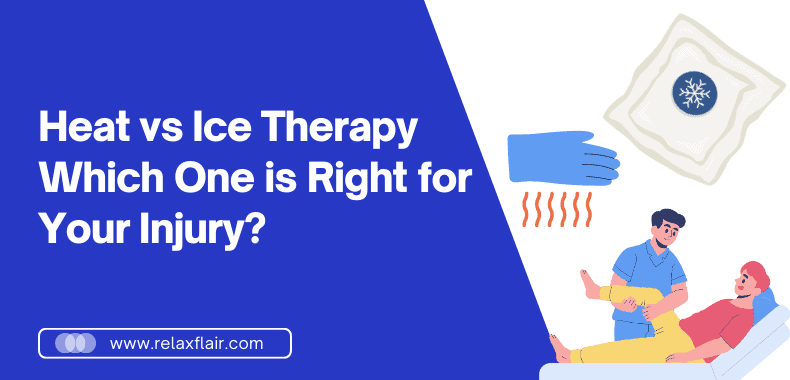Injuries, aches, and pains are an inevitable part of life, and when they happen, many of us turn to ice or heat therapy for relief. Both ice and heat have been used for centuries to treat various types of pain, inflammation, and swelling.
Yet, making the correct choice in therapy for your particular issue is vital to obtaining optimal outcomes. Ice therapy is generally used to reduce swelling and inflammation, whereas heat therapy is the preferred method for aiding in healing and providing pain relief.
Understanding the science behind these therapies and knowing when to use which can make all the difference in your recovery process. In this post, we’ll dive deeper into the benefits and drawbacks of ice and heat therapy and provide guidance on when to use each one for optimal results.
What is Ice Therapy?
Ice therapy, also known as cryotherapy, involves the application of ice or a cold pack to an affected area of the body. The cold temperature causes blood vessels in the area to constrict, which decreases blood flow and reduces inflammation and swelling.
 Ice therapy is commonly used to treat acute injuries such as sprains, strains, and bruises, as well as chronic conditions such as arthritis and overuse injuries. It can be particularly effective in the first 24-48 hours after an injury, as it can help to prevent or minimize swelling and inflammation.
Ice therapy is commonly used to treat acute injuries such as sprains, strains, and bruises, as well as chronic conditions such as arthritis and overuse injuries. It can be particularly effective in the first 24-48 hours after an injury, as it can help to prevent or minimize swelling and inflammation.
To apply ice therapy correctly, wrap an ice pack in a towel or cloth and apply it to the affected area for 10-20 minutes at a time, with at least a 20-minute break in between applications. Be cautious with ice therapy if you have decreased sensation or circulation, as it can cause tissue damage. Do not apply ice directly to the skin, as this can cause skin damage and frostbite.
Some interesting facts:
- Through constricting blood vessels, numbing pain, and decreasing inflammation in a targeted region, ice therapy is an effective tool for diminishing swelling and facilitating recovery.
- The ancient Greeks and Romans used ice therapy to treat pain and swelling, and ice was commonly used in sports medicine as early as the 1920s.
- Ice therapy is often used in conjunction with other treatments, such as rest, compression, and elevation, to help manage pain and swelling in injuries such as sprains, strains, and bruises.
- Ice therapy can also be beneficial for certain medical conditions, such as arthritis, where inflammation is a key factor in pain and discomfort.
- To get the most out of your ice therapy, it is advisable to apply 20 minutes of cold treatment, followed by a break for another 20 minutes period. Repeat this cycle 2-3 times in a day for optimal results.
- Not only is ice therapy beneficial for relieving soreness and muscle fatigue, but it can also be employed to improve one’s appearance – from decreasing puffiness and diminishing dark circles around the eyes.
- Ice therapy should be avoided in cases of Raynaud’s disease, as it can exacerbate the condition which causes an extreme constriction of blood vessels in the fingers and toes.
What is Heat Therapy?
Heat therapy, also known as thermotherapy, involves the application of heat to an affected area of the body. The increased temperature promotes blood flow, relaxes muscles, tendons, and ligaments, and can help to relieve pain.
Heat therapy is commonly used to treat chronic conditions such as muscle and joint pain, stiffness, and spasms. It can also be effective in reducing menstrual cramps and back pain.
 To apply heat therapy correctly, wrap a heat pack in a towel or cloth and apply it to the affected area for 15-20 minutes at a time, with at least a 20-minute break in between applications.
To apply heat therapy correctly, wrap a heat pack in a towel or cloth and apply it to the affected area for 15-20 minutes at a time, with at least a 20-minute break in between applications.
Heat therapy should be completely evaded for acute injuries or areas with swelling, as it will only heighten the symptoms. If you have diminished sensation or circulation, use extra caution when undergoing heat treatment; this can cause burns and tissue destruction without proper care.
Heat therapy is a common feature found in many modern massage chairs, providing a relaxing and soothing experience. Massage chairs typically use heated rollers or pads to deliver heat therapy. By increasing blood flow and circulation, heat therapy can help promote healing and reduce inflammation, making it particularly beneficial for those with chronic pain or tension. The heat can also help to warm up and loosen tight muscles, making them more receptive to massage techniques.
Most massage chairs with heat therapy offers adjustable intensity and temperature settings, allowing users to customize their massage experience. Using heat therapy in conjunction with other massage techniques can provide a more comprehensive treatment. Massage chairs with heat therapy are a convenient and affordable option for those seeking relief from muscle pain and tension. It’s important to follow the manufacturer’s instructions and use heat therapy in massage chairs safely and responsibly.
Precautions and Risks For Both Methods
Maintaining safety should be a top priority when using either ice or heat therapy, so it is essential to recognize the potential risks associated with both. When utilizing ice treatment, exercise caution if you have impaired sensation or circulation, and never apply directly on bare skin.
Similarly for heat therapy, refrain from applying heat over an injury that’s fresh or a part of your body exhibiting swelling/inflammation; proceed carefully if you feel tingling due to poor circulation.
In the end, using heat and cold therapy can be advantageous when it comes to alleviating pain and hastening healing. Learning about the advantages and disadvantages of each treatment method is essential in order to make sure they are being used efficiently; doing so will ultimately expedite your recuperation process.
Ice Therapy
- Do not use ice therapy for more than 20 minutes at a time, as prolonged exposure to cold can damage tissues and nerves.
- Applying ice therapy to an open wound or skin conditions such as dermatitis or eczema can cause further distress and harm, so it is best to avoid using this method in these circumstances.
- Exercise caution when using ice therapy on vulnerable areas like the knees, elbows, and spine; these body parts possess less cushioning making them more prone to incurring tissue damage from cold temperatures.
Heat Therapy
- To avoid burns or tissue damage, limit your heat therapy sessions to no more than 20 minutes. Prolonged exposure of any kind could have adverse effects on the skin and body.
- Avoid using heat therapy on areas of the body that have reduced sensation or inadequate circulation, as this can lead to tissue damage and severe burns.
- Exercise extreme caution when applying heat therapy on delicate parts of the body, such as your face or genitals. These fragile regions are more prone to burns and discomfort due to their thin skin.
Taking the time to pay attention to your body and make necessary modifications is essential. If you feel any more pain, discomfort, or other signs of distress, it’s best to immediately cease therapy and consult a medical expert. Additionally, prior to beginning any new kind of treatment – especially when living with preexisting illnesses or on medication – speaking with your physician or physical therapist first is highly recommended.
When to Use Heat or Ice on Muscles
Knowing the advantages and disadvantages of using either heat or ice on your muscles can be perplexing, yet with a little research you can make an educated decision. Here are some guidelines to consider when deciding whether to use heat or ice:
Ice therapy is a great way to manage acute injuries like strains, sprains, and bruises. Not only can it help to reduce swelling, but its cold temperature also numbs pain and prevents the inflammation that often accompanies such incidents.
It’s especially useful in treating overuse conditions like tendinitis where irritation contributes significantly to discomfort. However, one should avoid using ice therapy for chronic issues including fibromyalgia or arthritis as this could worsen symptoms instead of alleviating them.
Heat therapy is a highly recommendable solution for chronic conditions such as arthritis, where stiffness and tension are widespread. The warmth increases blood flow to the region, resulting in relaxation and decreased pain sensations. Furthermore, heat treatments can be beneficial when managing overuse injuries like tendinitis since it loosens up tight muscles while increasing flexibility. Nonetheless, it’s essential to avoid applying heat on acute traumas or circumstances considering that this could spark inflammation and swellings even more.
It is crucial to recognize that every person and injury is distinct, so it’s wise to reach out to a healthcare professional before beginning any new therapy. They can ascertain which treatment method fits your particular needs as well as provide advice on how you can use it securely and with optimal results.
Frequently Asked Questions
Does Ice Help with Inflammation?
Yes, ice can help with inflammation. When an injury occurs, the body’s natural response is to increase blood flow to the affected area, causing inflammation. Inflammation is a necessary part of the recovery process, but it can also bring about pain, stiffness, and swelling.
Applying ice to an affected area helps to reduce inflammation by minimizing the circulation in blood vessels while obstructing fluid build-up; consequently reduced pain and faster healing times are achieved. It’s important to remember that this form of therapy should only be used for acute injuries and not as a remedy for chronic conditions – else it could potentially worsen symptoms instead.
Does Ice Help Swelling After 3 Days?
Ice therapy can still be beneficial for swelling after three days, depending on the severity and type of injury. While the initial inflammatory response typically lasts for 2-3 days, secondary inflammation can occur as the body continues to heal. Applying ice to the affected area can help to reduce secondary inflammation and provide pain relief. However, after the first 48-72 hours, it’s also important to incorporate other forms of treatment such as gentle stretching, compression, and elevation to promote healing and prevent stiffness. As always, it’s best to consult with a healthcare professional for personalized advice on the best course of treatment for your specific injury.
Should You Put Heat on a Muscle Before or After Icing It?
When dealing with muscle pain or injury, understanding the appropriate use of heat and ice can significantly impact recovery. The order and timing of applying heat and ice depend on the type and stage of the injury. Let’s explore the scientific reasoning behind the correct application to optimize healing and pain relief.
Acute Phase: Start with Ice
Immediately after a muscle injury, such as a strain or sprain, the body initiates an inflammatory response. This acute phase typically lasts for the first 48-72 hours. During this time, blood vessels in the affected area dilate, increasing blood flow and leading to swelling, redness, and warmth. Applying ice during this phase is crucial.
Ice acts as a vasoconstrictor, narrowing blood vessels, which helps to reduce swelling and inflammation. By limiting blood flow to the injured area, ice helps to prevent excessive swelling and provides pain relief through its numbing effect. The application of ice should be done in intervals of 15-20 minutes, ensuring a barrier like a cloth is placed between the ice and skin to prevent frostbite.
Transition to Heat: Subacute and Chronic Phases
Once the acute inflammation subsides, typically after 48-72 hours, switching to heat therapy can be beneficial. Heat is particularly useful during the subacute (post-72 hours) and chronic phases of muscle injury or soreness. Unlike ice, heat causes vasodilation, increasing blood flow to the affected area. This enhanced circulation aids in delivering oxygen and nutrients essential for healing and helps to remove metabolic waste products from the muscles.
Heat also has a soothing effect on sore, stiff muscles and can enhance flexibility and range of motion. It can be applied using heating pads, warm towels, or hot baths for 15-20 minutes at a time.
Alternating Ice and Heat: Contrast Therapy
In some cases, particularly with chronic injuries, alternating between ice and heat, known as contrast therapy, can be beneficial. This method uses the principles of vasoconstriction and vasodilation to create a pumping action that enhances circulation, reduces swelling, and speeds up the healing process. Start with ice for 10 minutes, followed by heat for 10 minutes, and repeat the cycle for 30-40 minutes.
To summarize, for acute muscle injuries, begin with ice to control inflammation and reduce pain. As the injury progresses into the subacute phase, transition to heat to promote healing and alleviate stiffness. In chronic conditions, consider contrast therapy to reap the benefits of both modalities. Always listen to your body and consult with a healthcare professional to tailor the treatment to your specific needs.
Conclusion
In conclusion, both ice and heat therapy can be effective treatments for pain and inflammation, depending on the type and severity of the injury. Heat for nerve pain is generally more effective while alternating ice and heat therapy can be beneficial for reducing inflammation and promoting healing.
When it comes to muscle pain, heat therapy is typically more effective for promoting relaxation and increasing blood flow, while ice therapy is more effective for reducing inflammation and pain. For a pulled muscle in the back, alternating ice and heat therapy can be particularly effective for reducing pain and promoting healing. Ultimately, the best approach will depend on the individual’s specific injury and medical history, and consulting with a healthcare professional is always recommended for personalized advice on the best course of treatment.
